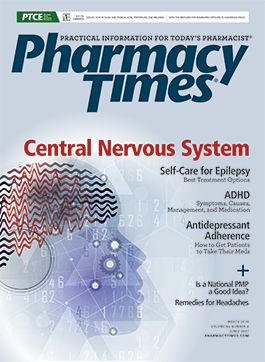Addressing the Risk of Cardiovascular Mortality in Adult Patients with Type 2 Diabetes and Established Cardiovascular Disease
This article was sponsored by Boehringer Ingelheim and Lilly.
Please see the Prescribing Information, including the Patient Information, forJardiance® (empagliflozin) tablets.
It is well understood that patients with type 2 diabetes (T2D) are at an increased risk of cardiovascular (CV) events.1 Because of the impact these events have on morbidity and mortality, it is important for pharmacists and other health care providers to be aware of opportunities to address and reduce this risk. This article will share results from a recent clinical trial that showed an existing treatment added to the standard of care resulted in a significant reduction in the risk of CV death in patients with T2D and established CV disease. With this treatment, adult patients with T2D and established CV disease may be prescribed a medication to both improve glycemic control as an adjunct to diet and exercise and to reduce the risk of CV death.
THE IMPACT OF T2D
According to the most recent estimates published by the CDC, 9.4% of the population in the United States has diabetes. Of these, 23.1 million individuals have received a diagnosis, but 7.2 million—nearly 1 in 4 patients (23.8%) —remain undiagnosed. Of adults with diagnosed diabetes, 90% to 95% have T2D.2 CV disease is the most common comorbidity in patients with T2D and is the most common cause of death among these patients.1,3
According to guidelines from the American Diabetes Association, diabetes management should include a comprehensive plan for reducing CV risk.4
JARDIANCE (EMPAGLIFLOZIN) TABLETS PRESCRIBING INFORMATION UPDATE
As of December 2016, the indication for JARDIANCE has been updated to reflect the results of the EMPA-REG OUTCOME trial. JARDIANCE, in addition to being indicated as an adjunct to diet and exercise to improve glycemic control in adults with T2D, is now indicated to reduce the risk of CV death in adult patients with T2D and established CV disease.5
JARDIANCE is not recommended for patients with type 1 diabetes or for the treatment of diabetic ketoacidosis.5
SELECT SAFETY INFORMATIONCONTRAINDICATIONS
JARDIANCE should not be used in patients with a history of serious hypersensitivity to empagliflozin or any of the excipients in JARDIANCE or in patients with severe renal impairment, end-stage renal disease, or dialysis.5
CARDIOVASCULAR DEATH RISK REDUCTION WITH JARDIANCE
Results of the EMPA-REG OUTCOME trial set JARDIANCE apart as the first glucose-lowering agent to demonstrate a reduction in the risk of CV death in a CV outcomes trial.6 JARDIANCE is the only oral T2D medication to receive an FDA-approved indication for reducing the risk of CV death in adult patients with T2D and established CV disease.5
In EMPA-REG OUTCOME, 7020 patients with T2D and with established CV disease were randomized in a 1:1:1 ratio to receive empagliflozin 10 mg daily, empagliflozin 25 mg daily, or placebo added to background glucose-lowering and CV therapies.7 At baseline, 30% were on monotherapy, 49% were on dual therapy, and 48% were on insulin (as monotherapy or as part of dual therapy). With regard to CV therapies, at baseline, 77% of patients were receiving a statin, 9% were receiving a fibrate, 83% were receiving acetylsalicylic acid, and 95% were receiving any drug for blood pressure reduction (81% were taking blockers of the renin-angiotensin system).7
Patients received treatment for a median of 2.6 years. The primary composite end point was CV death, nonfatal myocardial infarction (MI), or nonfatal stroke. The study was powered to show noninferiority and to test for superiority if noninferiority was proven.7
JARDIANCE showed a significant 38% reduction in the relative risk of CV death (HR, 0.62; 95% CI, 0.49-0.77) (3.7% absolute risk with empagliflozin vs 5.9% with placebo), 2.2% absolute risk reduction,
and a 14% reduction in overall relative risk of the primary composite end point of CV events (HR, 0.86; 95% CI, 0.74-0.99; P = .04). The absolute risk reduction for the composite end point was 1.6%. There
was no change in the risk of nonfatal MI (HR, 0.87; 95% CI, 0.70-1.09) or nonfatal stroke (HR, 1.24; 95% CI, 0.92-1.67). 7
SELECT SAFETY INFORMATIONWARNINGS AND PRECAUTIONSHypotension
JARDIANCE causes intravascular volume contraction and symptomatic hypotension may occur. Before initiating JARDIANCE, assess and correct volume status in the elderly, in patients with renal impairment, low systolic blood pressure, or on diuretics. Monitor for hypotension.5
Ketoacidosis
Reports of ketoacidosis, a serious life-threatening condition requiring urgent hospitalization have been identified in patients with type 1 and type 2 diabetes mellitus receiving sodium glucose co transporter 2 (SGLT2) inhibitors, including JARDIANCE. Fatal cases of ketoacidosis have been reported in patients taking JARDIANCE. Patients who present with signs and symptoms of metabolic acidosis should be assessed for ketoacidosis, even if blood glucose levels are less than 250 mg/dL. If suspected, discontinue JARDIANCE, evaluate and treat promptly.5
Before initiating JARDIANCE, consider risk factors for ketoacidosis. Patients on JARDIANCE may require monitoring and temporary discontinuation in situations known to predispose to ketoacidosis.5
Acute Kidney Injury and Impairment in Renal Function
JARDIANCE causes intravascular volume contraction and can cause renal impairment. Acute kidney injury requiring hospitalization and dialysis have been identified in patients taking SGLT2 inhibitors, including JARDIANCE; some reports involved patients younger than 65 years of age. Before initiating JARDIANCE, consider factors that may predispose patients to acute kidney injury including hypovolemia, chronic renal insufficiency, congestive heart failure and concomitant medications (diuretics, ACE inhibitors, ARBs, NSAIDs). Consider temporary discontinuation in settings of reduced oral intake or fluid losses. Monitor patients for signs and symptoms of acute kidney injury. If acute kidney injury occurs, discontinue JARDIANCE promptly and institute treatment.5
JARDIANCE increases serum creatinine and decreases eGFR. Patients with hypovolemia may be more susceptible to these changes. Renal function should be evaluated prior to initiating JARDIANCE and periodically thereafter. More frequent monitoring is recommended in patients with eGFR <60 mL/min/1.73 m2. JARDIANCE should be discontinued in patients with a persistent eGFR <45 mL/min/1.73 m2.5
ROLE OF THE PHARMACIST
Developing a comprehensive therapeutic plan to reduce CV morbidity and mortality in patients with T2D is an important clinical priority. To reduce the risk of CV events, pharmacists can stress the importance of blood pressure control, lipid control, smoking cessation, weight management, physical activity, and a healthy lifestyle.4
To further reduce risk, pharmacists can recommend that clinicians consider treatments proven to reduce CV mortality in clinical trials, and also educate patients regarding their treatment options. Considering the relative risk reduction in CV mortality shown in the EMPA-REG OUTCOME trial, JARDIANCE has an important role in reducing the risk of CV death among adult patients withT2D and established CV disease.7 By helping these patients and their health care providers understand the CV benefit of therapy, pharmacists can help reduce the risk of CV death in the patients they serve.
IMPORTANT SAFETY INFORMATIONCONTRAINDICATIONS
JARDIANCE should not be used in patients with a history of serious hypersensitivity to empagliflozin or any of the excipients in JARDIANCE or in patients with severe renal impairment, end-stage renal disease, or dialysis.
WARNINGS AND PRECAUTIONSHypotension
Empagliflozin causes intravascular volume contraction and symptomatic hypotension may occur. Before initiating JARDIANCE, assess and correct volume status in the elderly, and in patients with renal impairment, low systolic blood pressure, or on diuretics. Monitor for hypotension.
Ketoacidosis
Ketoacidosis, a serious life-threatening condition requiring urgent hospitalization, has been identified in patients with type 1 and type 2 diabetes mellitus receiving SGLT2 inhibitors, including empagliflozin. Fatal cases of ketoacidosis have been reported in patients taking empagliflozin. Patients who present with signs and symptoms of metabolic acidosis should be assessed for ketoacidosis, even if blood glucose levels are less than 250 mg/dL. If suspected, discontinue JARDIANCE, evaluate, and treat promptly. Before initiating JARDIANCE, consider risk factors for ketoacidosis. Patients may require monitoring and temporary discontinuation in situations known to predispose to ketoacidosis.
Acute Kidney Injury and Impairment in Renal Function
Empagliflozin causes intravascular volume contraction and can cause renal impairment. Acute kidney injury requiring hospitalization and dialysis have been identified in patients taking SGLT2 inhibitors, including empagliflozin; some reports involved patients younger than 65 years of age. Before initiating JARDIANCE, consider factors that may predispose patients to acute kidney injury. Consider temporary discontinuation in settings of reduced oral intake or fluid losses. Monitor patients for signs and symptoms of acute kidney injury. If it occurs, discontinue JARDIANCE and treat promptly.
Empagliflozin increases serum creatinine and decreases eGFR. Patients with hypovolemia may be more susceptible to these changes. Before initiating JARDIANCE, evaluate renal function and monitor thereafter. More frequent monitoring is recommended in patients with eGFR <60 mL/min/1.73 m2. Discontinue JARDIANCE in patients with a persistent eGFR <45 mL/min/1.73 m2.
Urosepsis and Pyelonephritis
Serious urinary tract infections including urosepsis and pyelonephritis requiring hospitalization have been identified in patients receiving SGLT2 inhibitors, including empagliflozin. Treatment with SGLT2 inhibitors increases the risk for urinary tract infections. Evaluate for signs and symptoms of urinary tract infections and treat promptly.
Hypoglycemia
The use of JARDIANCE in combination with insulin or insulin secretagogues can increase the risk of hypoglycemia. A lower dose of insulin or the insulin secretagogue may be required.
Genital Mycotic Infections
Empagliflozin increases the risk for genital mycotic infections, especially in patients with prior infections. Monitor and treat as appropriate.
Hypersensitivity Reactions
Discontinue JARDIANCE, treat promptly, and monitor until signs and symptoms resolve.
Increased Low-Density Lipoprotein Cholesterol (LDL-C)
Monitor and treat as appropriate.
MOST COMMON ADVERSE REACTIONS (>5%)
Urinary tract infections and female genital mycotic infections.
DRUG INTERACTIONS
Coadministration with diuretics may enhance the potential for volume depletion.
USE IN SPECIAL POPULATIONSPregnancy
JARDIANCE is not recommended, especially during the second and third trimesters.
Lactation
JARDIANCE is not recommended while breastfeeding.
Geriatric Use
JARDIANCE is expected to have diminished efficacy in elderly patients with renal impairment. Renal function should be assessed more frequently in elderly patients. The incidence of volume depletion-related adverse reactions and urinary tract infections increased in patients ≥75 years treated with empagliflozin.
INDICATIONS AND LIMITATIONS OF USE
JARDIANCE is indicated to reduce the risk of cardiovascular (CV) death in adults with type 2 diabetes mellitus and established CV disease.
JARDIANCE is indicated as an adjunct to diet and exercise to improve glycemic control in adults with type 2 diabetes mellitus.
JARDIANCE is not recommended for patients with type 1 diabetes or for the treatment of diabetic ketoacidosis.
CL-JAR-100004 12.19.17
REFERENCES
1. Roche MM, Wang PP. Sex differences in all-cause and cardiovascular mortality hospitalization for individuals with and without diabetes, and patients with diabetes diagnosed early and late. Diabetes Care. 2013;36(9):2582-2590. doi: 10.2337/dc12-1272.
2. CDC. National diabetes statistics report, 2017. CDC website. https://www.cdc.gov/diabetes/pdfs/data/statistics/national-diabetes-statistics-report.pdf. Accessed January 4, 2018.
3. International Diabetes Federation. IDF Diabetes Atlas. 5th ed. Brussels, Belgium: International Diabetes Federation; 2011. diabetesatlas.org/component/attachments/?task=download&id=70. Accessed January 4, 2018.
4. American Diabetes Association. Standards of medical care in diabetes—2017. Diabetes Care website. http://care.diabetesjournals.org/content/diacare/40/Supplement_1/S75.full.pdf. Published January 2017. Accessed January 4, 2018.
5. Jardiance (empagliflozin) tablets [prescribing information]. Ridgefield, CT: Boehringer Ingelheim Pharmaceuticals, Inc; 2017.
6. Cardiometabolic Health Congress. SGLT-2 inhibitor empagliflozin significantly reduces CV risk and mortality in CV outcomes trial. Cardiometabolic Health Congress website. http://blog.cardiometabolichealth.org/2015/09/18/sglt-2-inhibitor-empagliflozin-significantly-reduces-cv-risk-mortality-cv-outcomes-trial/. Published September 18, 2015. Accessed January 4, 2018.
7. Zinman B, Wanner C, Lachin JM, et al; EMPA-REG OUTCOME Investigators. Empagliflozin, cardiovascular outcomes, and mortality in type 2 diabetes. N Engl J Med. 2015;373(22):2117-2128. doi: 10.1056/NEJMoa1504720.
PC-US 102658


